Stabilization and Recycling of Sand in Pedestrian Walkways
Abstract
1. Introduction
2. Materials and Method
2.1. Recycled Sand
2.2. Binder
2.3. Manufacturing of Specimens
2.4. Testing of Specimens
3. Results and Discussion
3.1. Physico-Chemical Characteristics of Sand
3.2. Characteristics of Binders
3.3. Unconfined Compressive Strength of Samples
4. Conclusions
Author Contributions
Funding
Data Availability Statement
Acknowledgments
Conflicts of Interest
References
- French Ministry of Ecology. Observation and Statistics Service (SOeS) of the Ministry of Ecology, Sustainable Development and Energy; Review of the production of waste in France; French Ministry of Ecology: Paris, France, 2015. [Google Scholar]
- Behera, M.; Bhattacharyya, S.K.; Minocha, A.K.; Deoliya, R.; Maiti, S. Recycled aggregate from CDW waste & its use in concrete—A breakthrough towards sustainability in construction sector: A review. Constr. Build. Mater. 2014, 68, 501–516. [Google Scholar] [CrossRef]
- CESER. Avis du CESER sur le Dossier du Conseil Régional ‘Modification n°1 du Schéma Régional D’aménagement, de Développement Durable et D’égalité des Territoires’. Conseil Economique, Social et Environmental Régional. 2023. Available online: https://www.bretagne.bzh/app/uploads/sites/8/2023/06/Avis-du-CESER-sur-la-Modification-SRADDET-session-19-et-20-juin-2023.pdf (accessed on 5 November 2023).
- FFB. Déchets de Chantier: C’est Qoui la REP Bâtiment? French Building Federation. 2023. Available online: https://www.ffbatiment.fr/gestion-entreprise/organiser-mon-chantier/dechets-de-chantier-bonnes-pratiques-environnementales/dossier/dechets-de-chantier-c-est-quoi-la-rep-batiment (accessed on 5 November 2023).
- Aliaoui, F.; Belkadi, A. Etude de L’influence du Type des Granulats Recyclés sur le Comportement du Béton de Sable. Master’s Thesis, Université Yahia Fares de Medea, Médéa, Algeria, 2021; 102p. Available online: http://dspace.univ-medea.dz:8080/handle/123456789/805 (accessed on 25 October 2023).
- UNPG. Module D’information Environnementale de la Production de Granulats Recyclés. Union Nationale DES Producteurs de Granulats. 2017. Available online: www.unpg-mie-production-granulats-recycles-2017-1.pdf (accessed on 6 November 2023).
- Ben Fraj, A. Le Recyclage du Béton dans le Béton: Apport de la Recherche. Conférence Technique Territoriale, Sobriété, Frugalité et Réemploi. Metz, France. 2023. Available online: https://www.cerema.fr/system/files/documents/2023/02/5._presentation_beton_recycle_dima.pdf (accessed on 13 November 2023).
- Economic Unit of Brittany. Le Recyclage des Déchets du BTP en Bretagne: Quantification et Pratiques. 2021. Available online: https://www.bretagne.developpement-durable.gouv.fr/IMG/pdf/202112_rapport_recyclage_dechetsbtp_bzh.pdf (accessed on 6 November 2023).
- Angulo, S.C.; Ulsen, C.; John, V.M.; Kahn, H.; Cincotto, M.A. Chemical–mineralogical characterization of CDW waste recycled aggregates from São Paulo, Brazil. Waste Manag. 2009, 29, 721–730. [Google Scholar] [CrossRef] [PubMed]
- Silva, R.V.; Brito, J.; Dhir, R. Properties and composition of recycled aggregates from construction and demolition waste suitable for concrete production. Constr. Build. Mater. 2014, 65, 201–217. [Google Scholar] [CrossRef]
- Arabi, N.; Berredjem, L. Valorisation des déchets de démolition comme granulats pour bétons. Environ. Ingénierie Dév. 2021, 60, 25–30. [Google Scholar] [CrossRef]
- Sampaio, H.C.; Cazacliu, B.G.; Ambrós, W.M.; Kronbauer, M.A.; Tubino, R.M.C.; Dal Molin, D.C.C.; Oliva Moncunill, J.; Miltzarek, G.L.; Waskow, R.P.; dos Santos, V.L.G.; et al. Characterization of demolished concretes with three different strengths for recycling as coarse aggregate. Minerals 2021, 11, 803. [Google Scholar] [CrossRef]
- AFNOR NF EN 206+A2/CN; Béton—Spécification, Performance, Production et Conformité—Complément National à la Norme NF EN 206+A2. AFNOR: Saint-Denis, France, 2022.
- Andrzejuk, W.; Barnat-Hunek, D.; Góra, J. Physical properties of mineral and recycled aggregates used to mineral-asphalt mixtures. Materials 2019, 12, 3437. [Google Scholar] [CrossRef] [PubMed]
- Maimouni, H. Suivi des Echanges d’eau Dans un Mortier de Sable Recyclé Modèle à L’état Frais par une Approche Rhéologique. Ph.D. Thesis, École Centrale de Nantes, Nantes, France, 2018. [Google Scholar]
- Movahed, S.; Azad, S.P.; Zakeri, H. A safe pedestrian walkway; Creation of a safe public space based on pedestrian safety. Procedia—Soc. Behav. Sci. 2012, 35, 572–585. [Google Scholar] [CrossRef][Green Version]
- Moretti, L.; Di Mascio, P.; Fusco, C. Porous concrete for pedestrian pavements. Water 2019, 11, 2105. [Google Scholar] [CrossRef]
- Buchser, M. Revêtements de sol. Bureau de Prévention des Accidents. Berne. 2014. Available online: https://www.batidoc.ch/m10/85/41132285/etc/43/42087643.pdf (accessed on 8 November 2023).
- SMAEG. Guide de la Définition et des Bons Usages des Materiaux de Revetement et du Petit Mobilier Urbain Relatifs à L’espace public. Syndicat Mixte d’Action pour l’Expansion de la Gâtine. 2011. Available online: http://www.intragatine.org/paysgatine/portail2/ressources/guide-materiaux/materiaux-revetement/02-les_sols_stabilises-guide_materiaux_pays_gatine_2011.pdf (accessed on 5 November 2023).
- Shalabi, F.I.; Mazher, J.; Khan, K.; Alsuliman, M.; Almustafa, I.; Mahmoud, W.; Alomran, N. Cement-Stabilized Waste Sand as Sustainable Construction Materials for Foundations and Highway Roads. Materials 2019, 12, 600. [Google Scholar] [CrossRef] [PubMed]
- Afrin, H. A Review on Different Types Soil Stabilization Techniques. Int. J. Transp. Eng. Technol. 2017, 3, 19–24. [Google Scholar] [CrossRef]
- AFNOR NF EN 933-1; Essais Pour Déterminer les Caractéristiques Géométriques des Granulats—Partie 1: Détermination de la Granularité—Analyse Granulométrique par Tamisage. AFNOR: Saint-Denis, France, 2012.
- AFNOR NF EN 1097-6; Essais pour Déterminer les Caractéristiques Mécaniques et Physiques des Granulats—Partie 5: Détermination de la Teneur en eau par Séchage en Etuve Ventilée. AFNOR: Saint-Denis, France, 2008.
- AFNOR NF P94-093; Sols: Reconnaissance et Essais—Détermination des Références de Compactage d’un Matériau—Essai Proctor Normal—Essai Proctor Modifié. AFNOR: Saint-Denis, France, 2021.
- AFNOR NF EN 1744-1; Essais Pour Déterminer les Propriétés Chimiques des Granulats—Partie 1: Analyse Chimique. AFNOR: Saint-Denis, France, 1998.
- Rabbani, P.; Daghigh, Y.; Atrechian, M.A.; Karimi, M.; Tolooiyan, A. The potential of lime and grand granulated blast furnace slag (ggbfs) mixture for stabilisation of desert silty sands. J. Civ. Eng. Res. 2012, 2, 108–119. [Google Scholar] [CrossRef]
- METL. Ministère de l’Equipement, des Transports et du Logement—Assises de Chaussees Guide d’application des Normes pour le Reseau Routier National (French Ministry of Equipment, Transport and Housing—Road Bases Guide to the Application of Standards for the National Road Network); Service d’Etudes Techniques des Routes et Autoroutes (Technical Studies Service for Roads and Highways): Bagneux, France, 1998. [Google Scholar]
- Hussan, A.; Levacher, D.; Mezazigh, S.; Jardin, L. Valorization of a Highly Organic Sediment: From Conventional Binders to a Geopolymer Approach. J. Compos. Sci. 2022, 6, 147. [Google Scholar] [CrossRef]
- Ciments Calcia. Stabex, Esthétique et Performance des sols Stabilisés. Stabex. 2008. Available online: www.ciments-calcia.fr (accessed on 11 November 2023).
- IDRRIM. Acceptabilité Environnementale des Matériaux Alternatifs en Technique Routière, n°32, Institut Des Routes, des Rues et des Infrastructures pour la Mobilité. 2017. 17p. Available online: https://www.idrrim.com/ressources/documents/9/5044-NOTE-D-INFORMATION-N-32_VF.pdf (accessed on 29 October 2023).
- Cazacliu, B.; Cothenet, A. Etude de Faisabilité et Financière d’une Création de Plate-Forme de Valorisation de Déblais et Gravats du BTP; Internal Project Report; Gendrot TP Company: Rennes, France, 2021; 38p. [Google Scholar]
- McNeil, K.; Kang, T.H.K. Recycled Concrete Aggregates: A Review. Int. J. Concr. Struct. Mater. 2013, 7, 61–69. [Google Scholar] [CrossRef]
- AFNOR NF P 11-300; Exécution des Terrassements—Classification des Matériaux Utilisables dans la Construction des Remblais et des Couches de Forme d’Infrastructures Routières. AFNOR: Saint-Denis, France, 1992.
- AFNOR NF P18-545; Éléments de Définition, Conformité et Codification. AFNOR: Saint-Denis, France, 2021.
- GTR. Guide des Terrassements Routiers, Réalisation de Remblais et des Couches de Formes, Fascicules I et II, GTR SETRA-LCPC, 2nd ed.; IDRRIM: Paris France, 2000; 240p, ISBN 2-7208-3810-1. [Google Scholar]
- Daman, K.P. Supplementary cementing materials. In Developments in the Formulation and Reinforcement of Concrete, 2nd ed.; Woodhead Publishing Series in Civil and Structural Engineering; Woodhead Publishing: Sawston, UK, 2019; pp. 55–85. [Google Scholar] [CrossRef]
- Makusa, G.P. Soil Stabilization Methods and Materials in Engineering Practice: State of the Art Review. Ph.D. Thesis, Luleå University of Technology, Luleå, Sweden, 2012; 38p. Available online: https://www.diva-portal.org/smash/get/diva2:997144/FULLTEXT01.pdf (accessed on 10 November 2023).
- Moreno-Pérez, E.; Hernández-Ávila, J.; Rangel-Martínez, Y.; Cerecedo-Sáenz, E.; Flores AReyes-Valderrama, M.I.; Salinas-Rodríguez, E. Characterization and possible uses of recycled aggregates from construcction and demolition waste from Mexico City. Minerals 2018, 8, 237. [Google Scholar] [CrossRef]
- Ulsen, C.; Antoniassi, J.L.; Martins, I.M.; Kahn, H. High quality recycled sand from mixed CDW is that possible? J. Mater. Res. Technol. 2021, 12, 29–42. [Google Scholar] [CrossRef]
- Bouakba, H.; Rezzak, A. L’étude de Stabilisation de sol par L’ajout de Ciment et de Fibre Naturelles. Master’s Thesis, Université de Jijel, Jijel, Algeria, 2016; 114p. Available online: http://dspace.univ-jijel.dz:8080/xmlui/handle/123456789/7252 (accessed on 8 November 2023).
- Firoozi, A.A.; Olgun, C.G.; Firoozi, A.A.; Baghini, M.S. Fundamentals of soil stabilization. Int. J. Geo-Eng. 2017, 8, 26. [Google Scholar] [CrossRef]
- Saussaye, L. Traitement des Sols Aux Liants Hydrauliques: Aspects Géotechniques et Physicochimiques des Perturbations de la Solidification. Ph.D. Thesis, Université de Caen, Caen, France, 2012. [Google Scholar]
- Yadu, L.; Tripathi, R.K. Effects of granulated blast furnace slag in the engineering behavior of stabilized soft soils. Procedia Eng. 2013, 51, 125–131. [Google Scholar] [CrossRef]
- Roy, T.K. Influence of sand on strength characteristics of cohesive Soil for using as Subgrade of road. Procedia—Soc. Behav. Sci. 2013, 104, 218–224. [Google Scholar] [CrossRef]
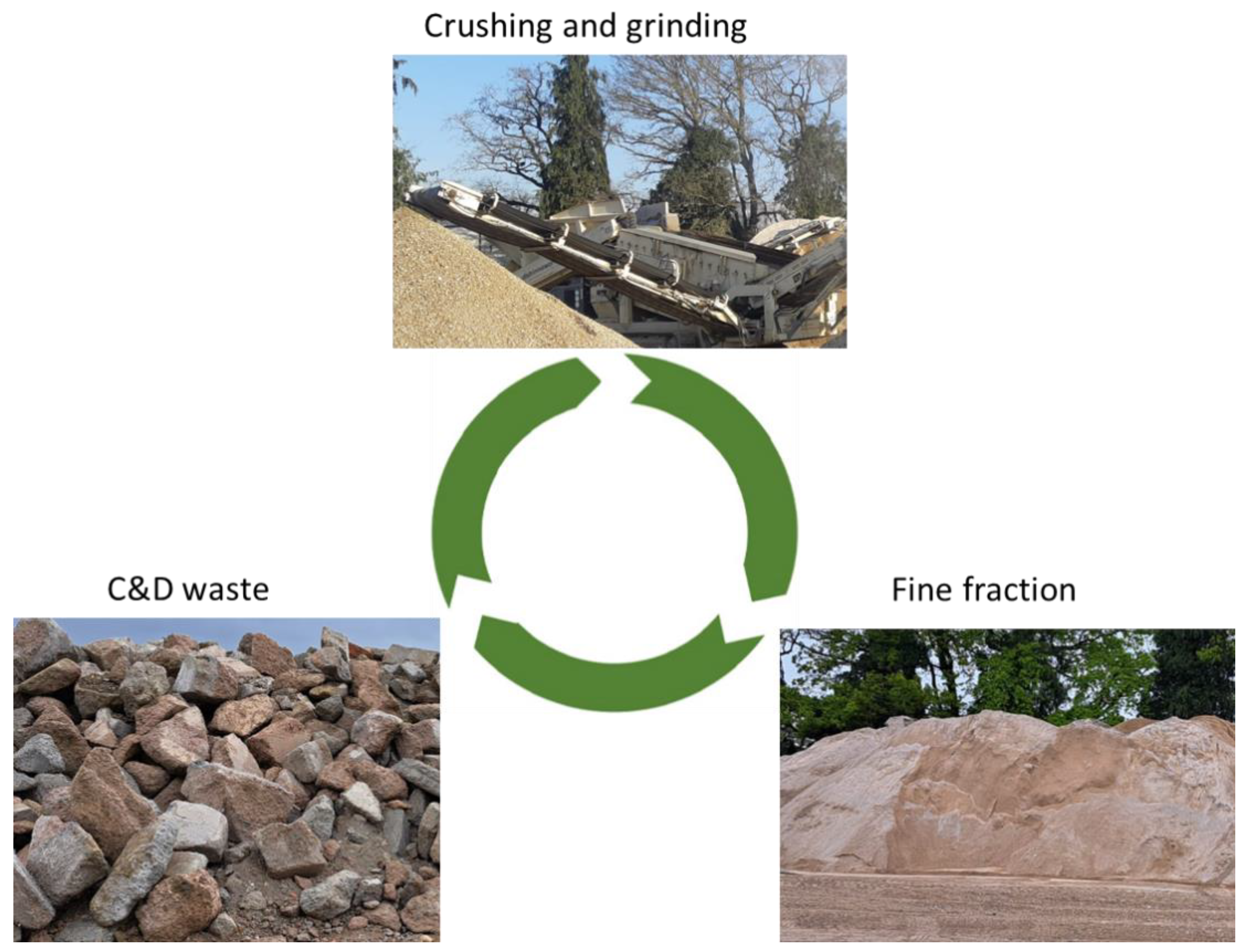

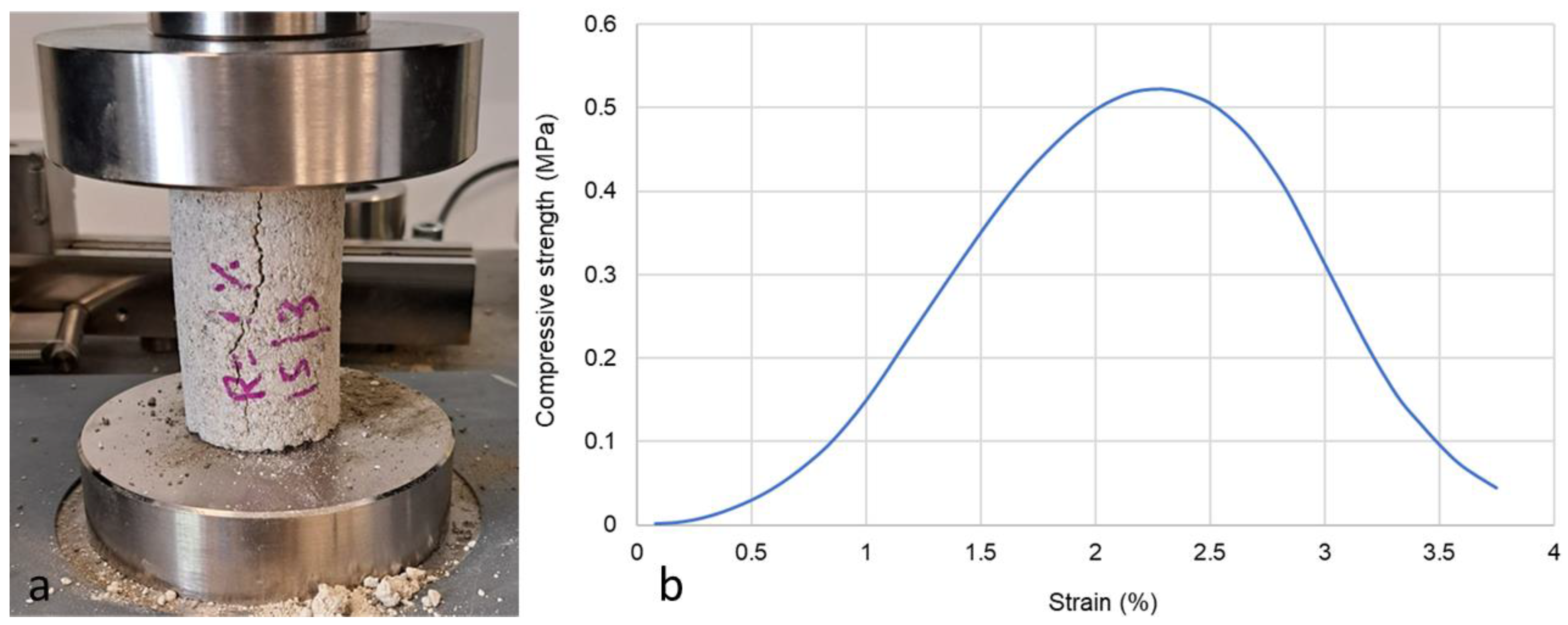
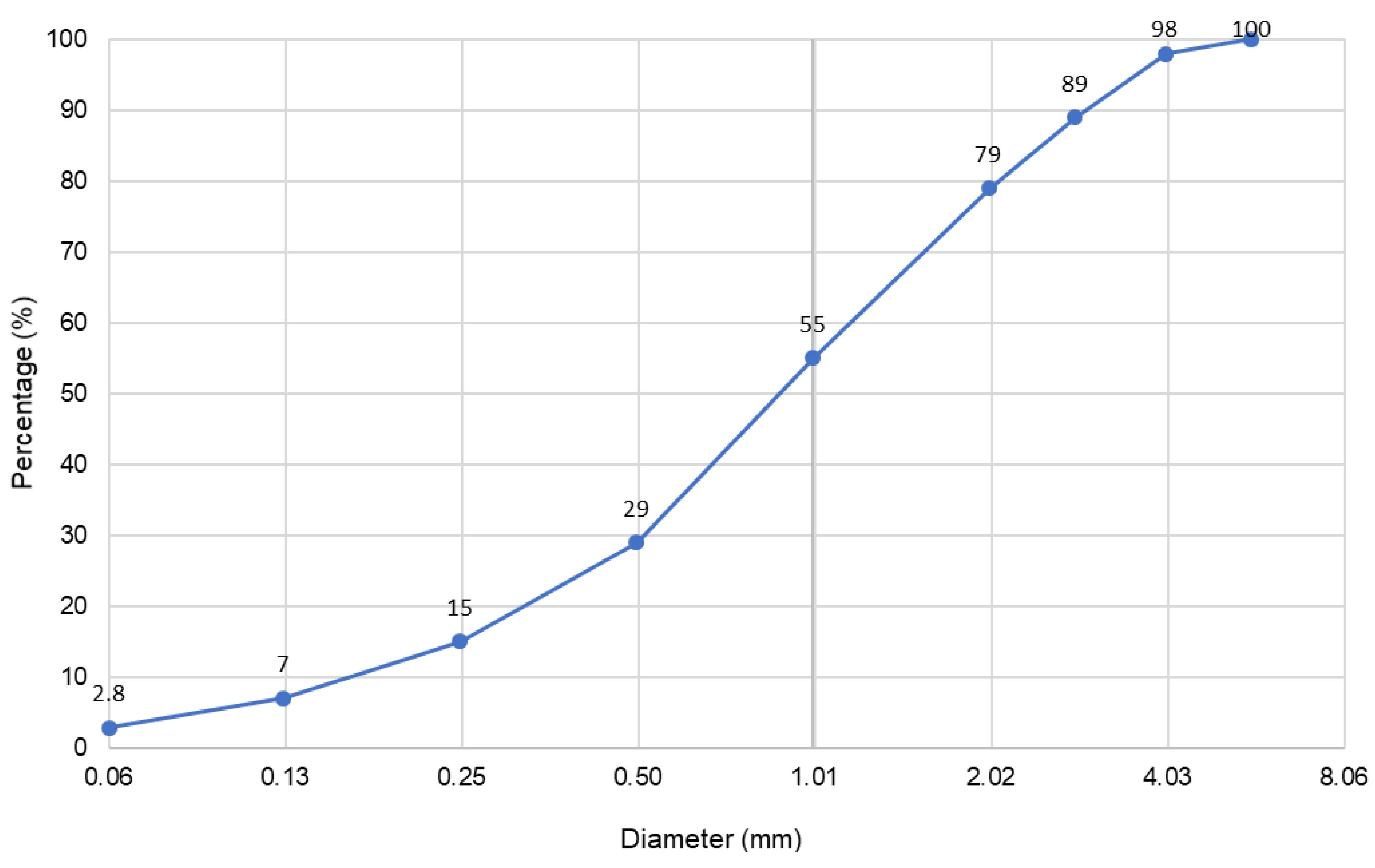
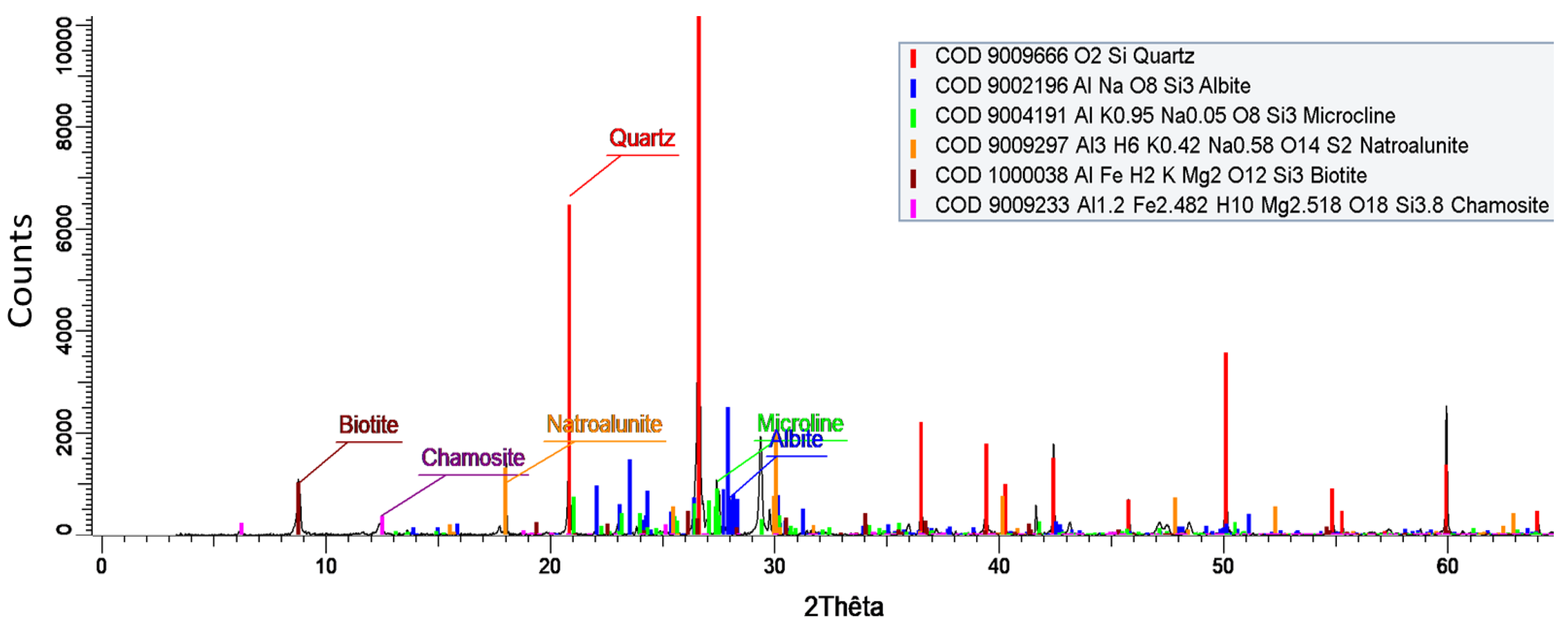
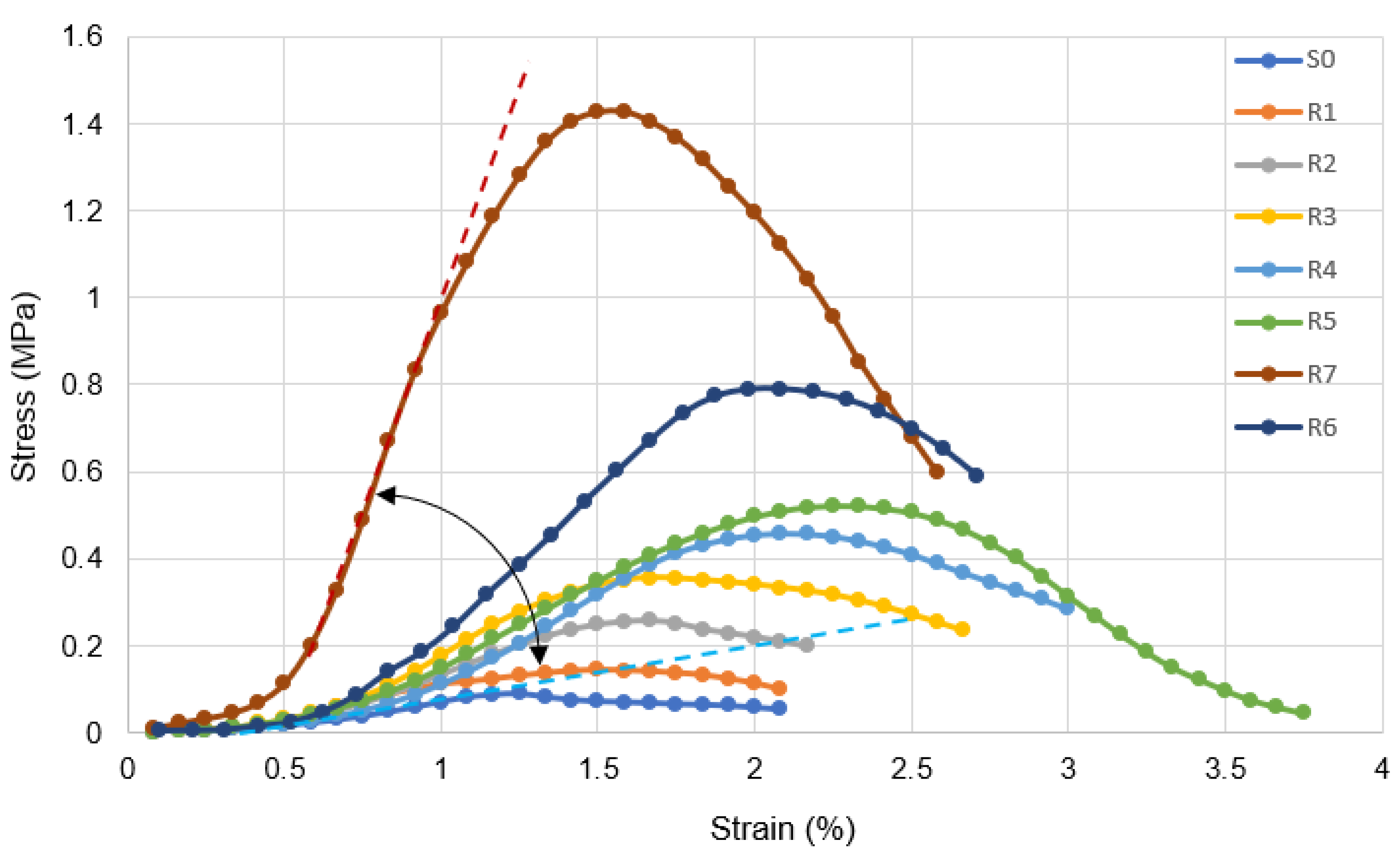

| Binder | Rolac | ECOSOIL® | GGBS |
|---|---|---|---|
| References | S0, R1, R2, R3 R4, R5, R6, R7 | S0, E1, E3 E5, E7 | S0, G1, G3 G5, G7 |
| Size | Wi (%) | Particles below 0.063 mm (%) | Particles below 4 mm (%) | Dmax (mm) | Classification GTR | SS (%) | MBV (g/100 g) | OWC (%) | ODD (g/cm3) | IBI |
|---|---|---|---|---|---|---|---|---|---|---|
| 0/4 mm | 7.2 | 2.8 | 98 | 8 | D2 | 0.51 | 0.05 | 11.3 | 1.8 | 35.1 |
| Unit (%) | SiO2 | CaO | AL2O3 | Fe2O3 | K2O | Others |
|---|---|---|---|---|---|---|
| Sand | 45.5 | 38.4 | 4.6 | 4.6 | 2.6 | 4.3 |
| Mineralogy | Quartz | Albite | Microcline | Natroalunite | Biotite | Chamosite |
|---|---|---|---|---|---|---|
| Concentration (%) | 43.3 | 26.5 | 12.8 | 10 | 5.4 | 2 |
| Rolac | GGBS | ECOSOIL® | |||
| Clinker | 80% | Slags | 95 ± 5% | LHF | 30% |
| Lime | 8% | Clinker | 5 ± 3% | LLD | 65% |
| Secondary constituents | 5% | pH | 9.8 | Regulator | 5% |
| CaO | 65% | CaO | 40% | - | - |
| SiO2 | 20.8% | SiO2 | 35% | - | - |
| Al2O3 | 5.4% | Al2O3 | 10% | - | - |
| Fe2O3 | 2.2% | MgO | 8% | - | - |
| Rc-7 | 44.9 MPa | Rc-7 days | 31 MPa | Rc-7 days | 21.7 MPa |
| Density (g/cm3) | - | - | 2.7 | ||
| Rolac | σc (MPa) | GGBS | σc (MPa) | ECOSOIL® | σc (MPa) |
|---|---|---|---|---|---|
| S0 | 0.1 | S0 | 0.1 | S0 | 0.1 |
| R1 | 0.1 | G1 | 0.2 | A1 | 0.2 |
| R2 | 0.2 | G3 | 0.3 | A3 | 0.2 |
| R3 | 0.3 | G5 | 0.3 | A5 | 0.2 |
| R4 | 0.5 | G7 | 0.5 | A7 | 0.5 |
| R5 | 0.5 | ||||
| R6 | 0.8 | ||||
| R7 | 1.2 |
| Sample | S0 | R1 | R2 | R3 | R4 | R5 | R6 | R7 | E1 | E3 | E5 | E7 | G1 | G3 | G5 | G7 |
|---|---|---|---|---|---|---|---|---|---|---|---|---|---|---|---|---|
| σc (MPa) | 0.1 | 0.1 | 0.2 | 0.3 | 0.5 | 0.5 | 0.8 | 1.2 | 0.2 | 0.2 | 0.2 | 0.5 | 0.2 | 0.3 | 0.3 | 0.5 |
| E (MPa) | 0.1 | 0.2 | 0.2 | 0.4 | 0.38 | 0.3 | 0.64 | 1.3 | 0.2 | 0.5 | 0.2 | 0.5 | 0.2 | 0.3 | 0.2 | 0.2 |
| ε (%) | 1.7 | 1.6 | 1.8 | 1.8 | 2.0 | 2.0 | 2.1 | 2.2 | 0.3 | 0.7 | 1.6 | 1.3 | 1.7 | 1.8 | 1.9 | 1.9 |
Disclaimer/Publisher’s Note: The statements, opinions and data contained in all publications are solely those of the individual author(s) and contributor(s) and not of MDPI and/or the editor(s). MDPI and/or the editor(s) disclaim responsibility for any injury to people or property resulting from any ideas, methods, instructions or products referred to in the content. |
© 2024 by the authors. Licensee MDPI, Basel, Switzerland. This article is an open access article distributed under the terms and conditions of the Creative Commons Attribution (CC BY) license (https://creativecommons.org/licenses/by/4.0/).
Share and Cite
Hussain, M.; Zmamou, H.; Provost, A.; Romero, P.A.H.; Mahieu, A.; Leblanc, N.; Levacher, D.; Kane, A. Stabilization and Recycling of Sand in Pedestrian Walkways. Buildings 2024, 14, 205. https://doi.org/10.3390/buildings14010205
Hussain M, Zmamou H, Provost A, Romero PAH, Mahieu A, Leblanc N, Levacher D, Kane A. Stabilization and Recycling of Sand in Pedestrian Walkways. Buildings. 2024; 14(1):205. https://doi.org/10.3390/buildings14010205
Chicago/Turabian StyleHussain, Mazhar, Hafida Zmamou, Antony Provost, Paula Andrea Higuera Romero, Angélique Mahieu, Nathalie Leblanc, Daniel Levacher, and Abdoulaye Kane. 2024. "Stabilization and Recycling of Sand in Pedestrian Walkways" Buildings 14, no. 1: 205. https://doi.org/10.3390/buildings14010205
APA StyleHussain, M., Zmamou, H., Provost, A., Romero, P. A. H., Mahieu, A., Leblanc, N., Levacher, D., & Kane, A. (2024). Stabilization and Recycling of Sand in Pedestrian Walkways. Buildings, 14(1), 205. https://doi.org/10.3390/buildings14010205







